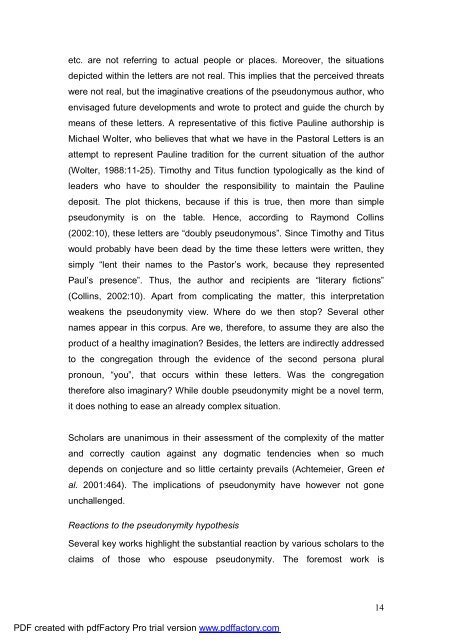A Text centred rhetorical analysis of Paul's Letter to Titus
A Text centred rhetorical analysis of Paul's Letter to Titus
A Text centred rhetorical analysis of Paul's Letter to Titus
Create successful ePaper yourself
Turn your PDF publications into a flip-book with our unique Google optimized e-Paper software.
etc. are not referring <strong>to</strong> actual people or places. Moreover, the situations<br />
depicted within the letters are not real. This implies that the perceived threats<br />
were not real, but the imaginative creations <strong>of</strong> the pseudonymous author, who<br />
envisaged future developments and wrote <strong>to</strong> protect and guide the church by<br />
means <strong>of</strong> these letters. A representative <strong>of</strong> this fictive Pauline authorship is<br />
Michael Wolter, who believes that what we have in the Pas<strong>to</strong>ral <strong>Letter</strong>s is an<br />
attempt <strong>to</strong> represent Pauline tradition for the current situation <strong>of</strong> the author<br />
(Wolter, 1988:11-25). Timothy and <strong>Titus</strong> function typologically as the kind <strong>of</strong><br />
leaders who have <strong>to</strong> shoulder the responsibility <strong>to</strong> maintain the Pauline<br />
deposit. The plot thickens, because if this is true, then more than simple<br />
pseudonymity is on the table. Hence, according <strong>to</strong> Raymond Collins<br />
(2002:10), these letters are “doubly pseudonymous”. Since Timothy and <strong>Titus</strong><br />
would probably have been dead by the time these letters were written, they<br />
simply “lent their names <strong>to</strong> the Pas<strong>to</strong>r’s work, because they represented<br />
Paul’s presence”. Thus, the author and recipients are “literary fictions”<br />
(Collins, 2002:10). Apart from complicating the matter, this interpretation<br />
weakens the pseudonymity view. Where do we then s<strong>to</strong>p? Several other<br />
names appear in this corpus. Are we, therefore, <strong>to</strong> assume they are also the<br />
product <strong>of</strong> a healthy imagination? Besides, the letters are indirectly addressed<br />
<strong>to</strong> the congregation through the evidence <strong>of</strong> the second persona plural<br />
pronoun, “you”, that occurs within these letters. Was the congregation<br />
therefore also imaginary? While double pseudonymity might be a novel term,<br />
it does nothing <strong>to</strong> ease an already complex situation.<br />
Scholars are unanimous in their assessment <strong>of</strong> the complexity <strong>of</strong> the matter<br />
and correctly caution against any dogmatic tendencies when so much<br />
depends on conjecture and so little certainty prevails (Achtemeier, Green et<br />
al. 2001:464). The implications <strong>of</strong> pseudonymity have however not gone<br />
unchallenged.<br />
Reactions <strong>to</strong> the pseudonymity hypothesis<br />
Several key works highlight the substantial reaction by various scholars <strong>to</strong> the<br />
claims <strong>of</strong> those who espouse pseudonymity. The foremost work is<br />
PDF created with pdfFac<strong>to</strong>ry Pro trial version www.pdffac<strong>to</strong>ry.com<br />
14

















